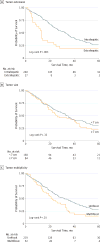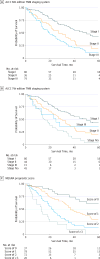Development and Validation of a Prognostic Score for Intrahepatic Cholangiocarcinoma
- PMID: 28297009
- PMCID: PMC5624806
- DOI: 10.1001/jamasurg.2017.0117
Development and Validation of a Prognostic Score for Intrahepatic Cholangiocarcinoma
Abstract
Importance: In patients with intrahepatic cholangiocarcinoma (ICC), the oncologic benefit of surgery and perioperative outcomes for large multifocal tumors or tumors with contiguous organ involvement remain to be defined.
Objectives: To develop and externally validate a simplified prognostic score for ICC and to determine perioperative outcomes for large multifocal ICCs or tumors with contiguous organ involvement.
Design, setting, and participants: This study of a contemporary cohort merged data from the California Cancer Registry (January 1, 2004, through December 31, 2011) and the Office of Statewide Health Planning and Development inpatient database. Clinicopathologic variables were compared between tumors that were intrahepatic, small (<7 cm), and solitary (ISS) and those that had extrahepatic extension and were large (≥7 cm) and multifocal (ELM). External validation of the prognostic model was performed using an independent data set from the National Cancer Institute's Surveillance, Epidemiology, and End Results database from January 1, 2004, through December 31, 2013.
Main outcomes and measures: Patient overall survival after hepatectomy.
Results: A total of 275 patients (123 men [44.7%] and 152 women [55.3%]; median [interquartile range] age, 65 [55-72] years) met the inclusion criteria. No significant differences in overall complication rate (ISS, 48 [34.5%]; ELM, 37 [27.2%]; P = .19) and mortality rate (ISS, 10 [7.2%]; ELM, 6 [4.4%]; P = .32) were found. A multivariate Cox proportional hazards model demonstrated that multifocality, extrahepatic extension, grade, node positivity, and age greater than 60 years are independently associated with worse overall survival. These variables were used to develop the MEGNA prognostic score. The prognostic separation/discrimination index was improved with the MEGNA prognostic score (0.21; 95% CI, 0.11-0.33) compared with the staging systems of the American Joint Committee on Cancer sixth (0.17; 95% CI, 0.09-0.29) and seventh (0.18; 95% CI, 0.08-0.30) editions.
Conclusions and relevance: The MEGNA prognostic score allows more accurate and superior estimation of patient survival after hepatectomy compared with current staging systems.
Conflict of interest statement
Figures


Comment in
-
Association of Unsolicited Patient Observations With the Quality of a Surgeon's Care.JAMA Surg. 2017 Jun 1;152(6):530. doi: 10.1001/jamasurg.2016.5705. JAMA Surg. 2017. PMID: 28199449 No abstract available.
-
Staging for Intrahepatic Cholangiocarcinoma: Are We Getting Close to Understanding the True Tumor Biology?JAMA Surg. 2017 May 17;152(5):e170108. doi: 10.1001/jamasurg.2017.0108. Epub 2017 May 17. JAMA Surg. 2017. PMID: 28296998 No abstract available.
-
Clinicopathological Factors Associated With Prognosis of Patients With Intrahepatic Cholangiocarcinoma After Hepatectomy.JAMA Surg. 2018 Jan 1;153(1):91-92. doi: 10.1001/jamasurg.2017.3483. JAMA Surg. 2018. PMID: 28973136 No abstract available.
-
Clinicopathological Factors Associated With Prognosis of Patients With Intrahepatic Cholangiocarcinoma After Hepatectomy-Reply.JAMA Surg. 2018 Jan 1;153(1):92. doi: 10.1001/jamasurg.2017.3480. JAMA Surg. 2018. PMID: 28973297 No abstract available.
References
-
- Aljiffry M, Abdulelah A, Walsh M, Peltekian K, Alwayn I, Molinari M. Evidence-based approach to cholangiocarcinoma: a systematic review of the current literature. J Am Coll Surg. 2009;208(1):134–147. - PubMed
-
- Shaib YH, Davila JA, McGlynn K, El-Serag HB. Rising incidence of intrahepatic cholangiocarcinoma in the United States: a true increase? J Hepatol. 2004;40(3):472–477. - PubMed
-
- Chang KY, Chang JY, Yen Y. Increasing incidence of intrahepatic cholangiocarcinoma and its relationship to chronic viral hepatitis. J Natl Compr Canc Netw. 2009;7(4):423–427. - PubMed
Publication types
MeSH terms
Grants and funding
LinkOut - more resources
Full Text Sources
Other Literature Sources
Medical
Miscellaneous

